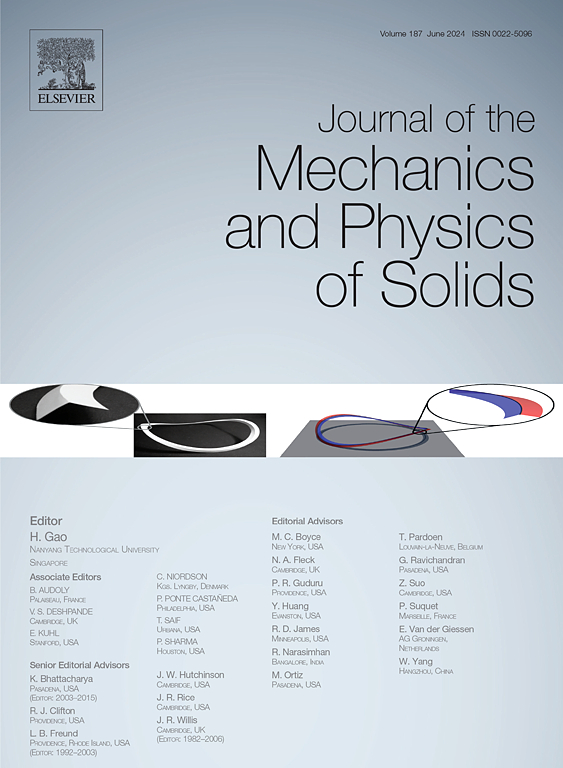A theory of fatigue fracture in viscoelastic solids
IF 5
2区 工程技术
Q2 MATERIALS SCIENCE, MULTIDISCIPLINARY
引用次数: 0
Abstract
Crack propagation in viscoelastic solids under cyclic loading is a fundamental problem underlying the fatigue fracture of elastomers. We present a continuum theory to determine the crack extension per loading cycle for various loading amplitudes, loading frequencies and viscoelastic properties. This is achieved by examining the energy dissipated through viscous effects and the energy available for driving crack growth. In particular, energy dissipation is controlled by an interplay of three time scales: the material relaxation time, the timescale associated with crack propagation (i.e., crack speed) and the loading frequency. By tracking the stress history of material points around the crack tip under concurrent crack propagation and cyclic loading, we derive an integral equation governing crack speed within a loading cycle. Comparisons between numerical solutions of our theory and finite element simulations demonstrate that our theory predicts the influence of material parameters and loading conditions on fatigue fracture at a much lower computational cost.
求助全文
约1分钟内获得全文
求助全文
来源期刊
CiteScore
9.80
自引率
9.40%
发文量
276
审稿时长
52 days
期刊介绍:
The aim of Journal of The Mechanics and Physics of Solids is to publish research of the highest quality and of lasting significance on the mechanics of solids. The scope is broad, from fundamental concepts in mechanics to the analysis of novel phenomena and applications. Solids are interpreted broadly to include both hard and soft materials as well as natural and synthetic structures. The approach can be theoretical, experimental or computational.This research activity sits within engineering science and the allied areas of applied mathematics, materials science, bio-mechanics, applied physics, and geophysics.
The Journal was founded in 1952 by Rodney Hill, who was its Editor-in-Chief until 1968. The topics of interest to the Journal evolve with developments in the subject but its basic ethos remains the same: to publish research of the highest quality relating to the mechanics of solids. Thus, emphasis is placed on the development of fundamental concepts of mechanics and novel applications of these concepts based on theoretical, experimental or computational approaches, drawing upon the various branches of engineering science and the allied areas within applied mathematics, materials science, structural engineering, applied physics, and geophysics.
The main purpose of the Journal is to foster scientific understanding of the processes of deformation and mechanical failure of all solid materials, both technological and natural, and the connections between these processes and their underlying physical mechanisms. In this sense, the content of the Journal should reflect the current state of the discipline in analysis, experimental observation, and numerical simulation. In the interest of achieving this goal, authors are encouraged to consider the significance of their contributions for the field of mechanics and the implications of their results, in addition to describing the details of their work.

 求助内容:
求助内容: 应助结果提醒方式:
应助结果提醒方式:


